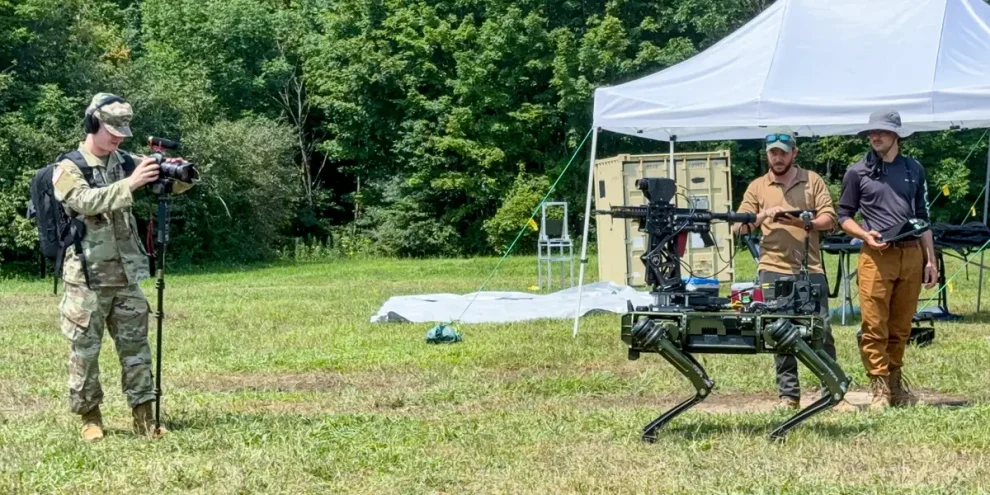The U.S. Army is testing robot dogs armed with AI-enabled rifle turrets in the Middle East for counter-drone capabilities. Explore the implications of this cutting-edge technology.
As the scorching sun beats down on the Red Sands Integrated Experimentation Center in Saudi Arabia, a peculiar sight catches my eye. Amidst the usual military hardware, a four-legged machine moves with eerie precision, its body supporting what appears to be an AR-15 pattern rifle on a rotating turret. This is no ordinary weapon system – it’s the U.S. Army’s latest experiment in counter-drone technology: an AI-enabled robot dog.
Today, on October 1, 2024, I’m witnessing firsthand the Army’s bold step into the future of warfare. The integration of artificial intelligence with unmanned ground vehicles marks a significant shift in military strategy, particularly in the realm of counter-drone operations.
The Ghost Robotics Vision 60
At the heart of this experiment is the Ghost Robotics Vision 60 Quadrupedal-Unmanned Ground Vehicle, or Q-UGV. This robot dog, armed with an AI-enabled gun turret, is undergoing rigorous testing as part of a counter-unmanned aerial system exercise.
We’re pushing the boundaries of what’s possible in modern warfare,” explains Major Sarah Thompson, lead coordinator for the exercise. “These Q-UGVs offer us capabilities that were once confined to the realm of science fiction.”
The specialized gun turret, emblazoned with “Lone Wolf” on its side, features a large electro-optical targeting system. It’s the same system that the Army recently tested during Operation Hard Kill at Fort Drum, New York, in August.
Enhancing Counter-Drone Capabilities
As I observe the robot dog in action, it becomes clear that this is no mere demonstration of firepower. The AI system integrated into the turret is designed to identify, track, and engage potential airborne threats with a level of precision that surpasses human capabilities.
The AI component is a game-changer,” says Dr. Alan Reeves, a military AI specialist observing the tests. “It can process information and make targeting decisions in milliseconds, potentially saving lives in the process.”
During the September test, the armed robot dog engaged several static ground targets, showcasing its potential in various combat scenarios. However, its primary focus remains on counter-drone operations, a growing concern for U.S. forces in the Middle East and beyond.
The Evolving Landscape of Military Robotics
The introduction of armed robot dogs is part of a broader trend in military technology. Over the past few years, the Department of Defense has been gradually incorporating these quadrupedal machines into various roles, from explosive ordnance disposal to perimeter security.
“Robot dogs have proven their worth in numerous non-combat roles,” explains Colonel James Harrison, who oversees robotic integration for the Army. Now, we’re exploring their potential in more direct combat support functions.
This development isn’t limited to the United States. In May, the Chinese People’s Liberation Army debuted its own armed robot dog during a training exercise in Cambodia, signaling a global race in this emerging technology.
Cost-Effective Counter-Drone Solutions
One of the driving factors behind the development of AI-enabled robot dogs is the need for cost-effective counter-drone solutions. Traditional surface-to-air missiles are often too expensive to use against relatively cheap weaponized drones.
“We’re looking at a significant reduction in cost-per-kill,” explains Major Thompson. An AI-powered system like this can potentially neutralize drone threats for just a few dollars per engagement, compared to hundreds of thousands for conventional missile systems.
This cost-effectiveness extends beyond just ammunition. By deploying robot dogs, human soldiers can be freed up for other critical tasks, potentially reducing risk and improving overall operational efficiency.
Ethical Considerations and Future Implications
As impressive as the technology is, it raises important ethical questions about the role of AI in warfare. Dr. Elena Sanchez, an expert in military ethics, voices her concerns:
While the potential benefits are clear, we must carefully consider the implications of deploying autonomous weapons systems. There are complex moral and legal issues that need to be addressed.”
The Army is quick to emphasize that these tests are part of ongoing research and don’t necessarily represent imminent deployment plans. A DEVCOM spokesman stated, “These experiments allow us to explore the realm of the possible, but they don’t always translate directly into formal service-wide programs.
The Future of Military AI
As the sun sets on the Saudi Arabian desert, casting long shadows across the testing grounds, it’s clear that we’re witnessing a pivotal moment in military technology. The armed robot dog represents just one facet of the Pentagon’s broader push towards AI-enabled warfare.
Defense Secretary Lloyd Austin recently announced that the second tranche of the Pentagon’s “Replicator” initiative would focus explicitly on counter-drone systems. This underscores the military’s commitment to developing innovative solutions to emerging threats.
From the Containerized Weapon System to the Mission Master XT unmanned ground vehicle, a range of autonomous and semi-autonomous weapons are being explored. Each of these systems represents a step towards a future where AI plays an increasingly central role in military operations.
As I prepare to leave the Red Sands facility, the gravity of what I’ve witnessed settles in. The integration of AI with robotic platforms like the Q-UGV is not just a technological advancement; it’s a fundamental shift in the nature of warfare itself. While the full implications of this shift remain to be seen, one thing is certain: the battlefield of tomorrow will look very different from the one we know today.
















Add Comment